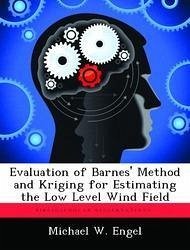This thesis evaluates two different methods of estimating a three dimensional wind field based upon a limited number of irregularly-spaced observations. This work was performed for the 45th Weather Squadron to determine how well the two methods worked and their potential for use in a visualization program. The two methods evaluated were Barnes' method and a method called Kriging, which is commonly used in geostatistics. Both of these estimation techniques were implemented and then evaluated to determine how accurate the estimates were that they created. The methods' accuracies were determined by withholding an observation from the observed wind field data set, performing the estimation, and then comparing the estimated value at the point of the withheld observation with the actual value withheld. These performance results were compared to determine which method produced a more accurate estimated wind field. Barnes' method proved to be the less complicated to implement, but Kriging provided a more accurate estimate. Both of the methods had a significant amount of estimation error associated with them. This large error casts serious doubt on their abilities to produce an accurate enough estimation to be useful in analyzing the low-level wind field.
Hinweis: Dieser Artikel kann nur an eine deutsche Lieferadresse ausgeliefert werden.
Hinweis: Dieser Artikel kann nur an eine deutsche Lieferadresse ausgeliefert werden.








